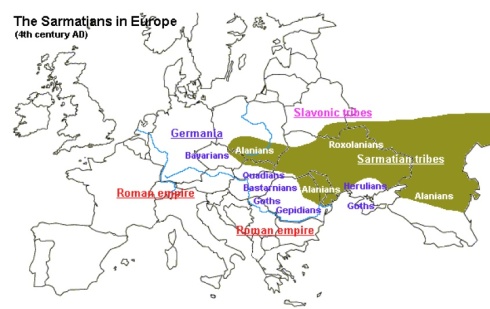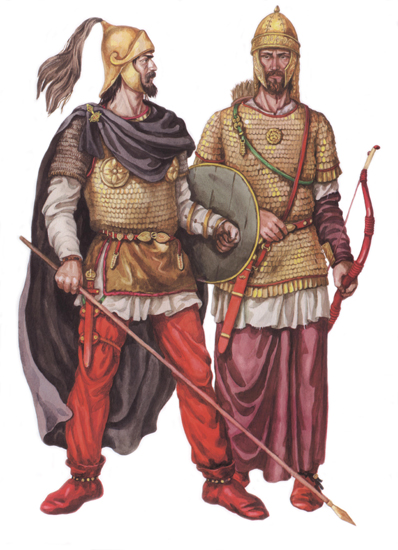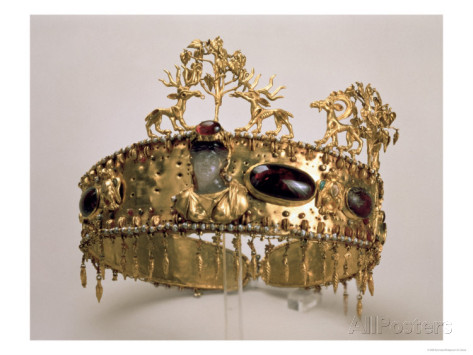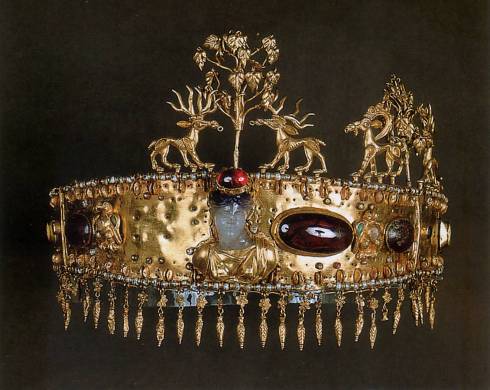You are currently browsing the tag archive for the ‘golden’ tag.

The Tang Dynasty (618-907 AD) was a glorious golden age of China when trade brought enormous prosperity to China and cosmopolitan city culture flourished. This exquisite wine cup came from the Tang capital, Chang’an, around 750 AD (the chalice was excavated in the city of Xi’an–which is Chang’an’s modern name–in 1957). According to the census of 742 AD, Chang’an had 1,960,188 people living in the metropolitan area (which included smaller suburban cities within the larger city). Such numbers make Chang’an the largest metropolis of its day (the other contenders would have been Baghdad and Constantinople, which were both about half the size).

This year, I want to talk more about Chang’an and about some of history’s other great super-cities. They tell us about the roots of contemporary urban culture (more than half of the world’s people today live in a city) and they maybe afford us a peak at the great cities of the future. For now though let us just savor the details of this solid gold goblet. Look at the birds and the design elements which come from coastal China and Central Asia! Cities ideally combine the best aspects of different groups of people and different cultures. MY home city, New York City certainly does that, on its good days, when it is not squeezing people to death for nickels. Speaking of home, this chalice is currently in New York, at the incomparable Metropolitan Museum of Art. Enjoy the goldsmith’s birds and the flowers–we will be back in Tang-era Chang’an for a real look around a few posts from now. And if, like me, you live in a city, start looking at it with a fresh critical eye. Cities are an even bigger part of the future than of the past, and we are going to need to make them better. Golden cups are not the only place where an idealized natural world of handmade beauty belongs…


One of the things which has surprised me most about this blog is how popular crowns are. Currently Ferrebeekeeper’s most popular post (in terms of traffic) is about the crowns of ancient Egypt. Because there are sooo many examples from practically every culture and timeframe, crowns are my go-to subject when I can’t think of anything to write about. In addition to a dazzling rainbow of visual styles from all history, crowns showcase the strange vicissitudes of history. Many crowns are steeped in stories of murder, cunning, and circumstances so peculiar they seem like something out of fiction (indeed it is the coronal outlier which sits harmlessly on a velvet pillow in a museum or cathedral for centuries). Yet people’s interest in these jeweled hats supersedes the fascinating historical tales behind individual crowns . When I wanted to write about catfish mascots or mollusk mascots I had to search the edges of the internet, but went to write about “royal” mascots I was overwhelmed by material—dancing queens, comic kings, playing cards, whiskey brands, tattoos, and all sorts of royal iconography on every sort of consumer good. Clearly even in our democracy, people are drawn to the symbolism and stagecraft of royalty.

Now, obviously, I want people to click on my blog posts and then enjoy perusing them! Yet I have always tried to be deliberately impertinent in how I write about crowns because I find their innate meaning to be troubling and I find the objects themselves to be almost as silly as they are impressive. Examples of crowns as high-status/royal items go back to the dawn of civilization, however the Greeks crafted an explanation of the meaning of crowns from within their religious/mythological symbology. Allegedly the sparkling points of light are meant to indicate a corona—a halo of light which indicates divine favor or divinity itself (this same idea was appropriated by the Christian church as a visual shorthand for saints, apostles, and angels).

So crowns (objects built by human hands) are meant to convey some sort of heavenly/supernatural status. It is indeed a telling combination: however it doesn’t reflect the divine right of kings but our species tendency to self-abasement in front of hierarchical authority. Primatologists (or their subjects) would understand this intuitively: put a shiny thing on your head to appear taller and more dazzling. This need for hierarchy allows us to organize and do amazing things, but it makes us susceptible to terrible leadership mistakes. To quote Sir Terry Pratchett “It seemed to be a chronic disease. It was as if even the most intelligent person had this little blank spot in their heads where someone had written: “Kings. What a good idea.” Whoever had created humanity had left in a major design flaw. It was its tendency to bend at the knees.”

I hoped that by writing about crowns I could deconstruct this concept a bit. Crowns are always being usurped by con-men, stolen by knaves, walled up inside cathedral storerooms, or melted into ingots by misguided revolutionaries. Although they are exceptional works of craft (and made of rare expensive materials), their history shows them to be anything but supernatural! They don’t reflect on a king so much as on his subjects who are inclined to take him at his word when he puts on a ridiculous spiky golden hat and says he is better than everyone.

Spring, spring, spring! Today is the first day that has actually felt like spring. Soon the forsythias will be up and then, suddenly all sorts of spring blossoms will appear in a riot of beautiful color. Forsythias are such a familiar blossoming shrubs that I have never thought to find out where they are from, and how they got here. The instantly familiar yellow flowers grow on long whiplike shoots and appear everywhere in early spring. They are the introductory notes from which the rest of the symphony swells (and yet they are always there beneath the rest of the music). Wasn’t it always that way?
Actually, forsythias are native to East Asia. Out of eleven wild species, only one obscure species had spread from Asia to southeastern Europe prior to the age of exploration. It wasn’t until the eighteenth century that western gardeners and botanists found out about them as traders and diplomats visited the great gardens of China, Korea, and Japan.
Forsythias are extremely easy to cultivate from cuttings. Low hanging boughs frequently already have rootlets. Europeans wasted no time in bringing the lovely yellow shrubs back home where they fed the public’s insatiable appetite for novelty. Indeed they were part of the 18th century Chinoiserie fad, which also gave us the monstrous invasive tree of heaven [spits on ground and curses]. Soon forsythias were in temperate gardens everywhere. They are coincidentally named for William Forsyth (1737–1804), a Scottish botanist who was the king’s head gardener and a founding member of the Royal Horticultural Society.
Ironically, despite the fact that forsythias have been omnipresent in American and European gardens since the late eighteenth century, they have not permeated very far into western culture. They are a beautiful shrub which is everywhere, but they do not have the same mythical and herbal associations for us as myrtles, redbuds, crocuses or such. Of course forsythias do have such associations in China, Korea, and Japan. They are one of the fundamental herbs of Chinese medicine and their sticks are used to manufacture a classical Korean stringed instrument. The myths and art of East Asia likewise favor the beautiful golden shrubs. The flower exemplify nature’s promise of rebirth.
One of my personal all-time favorite moments with flora and fauna involved forsythia…and my favorite animal—the mighty elephant. I was at the Bronx Zoo in early spring and their (then) adolescent female Asian elephant was outside appreciating the first nice day. Elephants eat lots of vegetation of all sorts and a thoughtful zookeeper had put a bunch of flowering forsythia fronds in the enclosure as a treat.
Elephants are arguably the most intelligent land animals except for certain problematic primates. They love to play and show off. The little elephant grabbed the beautiful yellow forsythias in her trunk and ran back and forth holding them aloft like a girl with a bouquet. Then, in a moment of pure exuberance, she threw them all high up in the air and raced back and forth in the resultant shower of bright yellow blossoms.
Since she was such a young elephant, she was still covered with fine downy hairs and the forsythia flowers got all caught up in these. So she became dotted with little golden flowers. She was beaming in delight and had one of the happiest expressions I have ever seen on anyone. The memory is enshrined in my heart as an enduring exemplar of joy. Although the internet had plenty of other sorts of images, I couldn’t find any happy elephants with forsythias–so I sketched one for you just now above,
The most important of Ghana’s crown jewels is not a crown at all but rather the legendary Sika ‘dwa, the Golden Stool which is believed to house the living spirit of all Ashanti people from all time. According to lore, the Stool descended from heaven into the lap of Osei Tutu, the first Ashanti king in 1701. At times struggle for control of the Golden Stool has devolved into war–including the eponymous “War for the Golden Stool” which broke out in 1900 when Sir Frederick Hodgson, governor of the British Gold Coast demanded to be allowed to sit on the Stool (which is a ceremonial object which is not meant to be sat upon—or even to directly touch the ground). Although the conflict left Great Britain in control of Ghana, the Golden Stool was hidden until 1920 when it was discovered and despoiled by a group of laborers who were promptly sentenced to death (although the British administrators commuted the sentence to perpetual banishment).
The stool is 18 inches high, 24 inches long, and 12 inches wide. It is covered with gold ornaments and has bells attached to it to warn the Ashanti tribe if danger is eminent. If you are confused by the above photo of the Golden Stool, that is because it is “lying down” (since it is not made to be sat upon anyway). Below is a picture of another Ashanti stool to give you a better idea of the object’s form. Even a non-royal, non-gold Ashanti stool is imbued with special meaning which edges toward the supernatural.
In 1999, King Otumfuo Osei Tutu II was crowned as the 16th leader of Ghana’s largest ethnic group, the Ashanti (although at this time in history, the king’s role is ceremonial and he is barred from serving in Ghana’s government). The golden stool made a fleeting ceremonial appearance before being returned to the secret location where it is kept. However the royal family has many other crown jewels which are worn on various state occasions—or just in general. On October 12, 2012, King Otumfuo Osei Tutu II was traveling in Oslo, Norway to attend a conference when jewel thieves made off with a bag containing many of the lesser crown jewels of Ghana (which they stole from the lobby of the Radisson Blu Plaza Hotel). It seems like the King of the Ashanti might have lost some of the splendid gold headdresses pictured here.
















